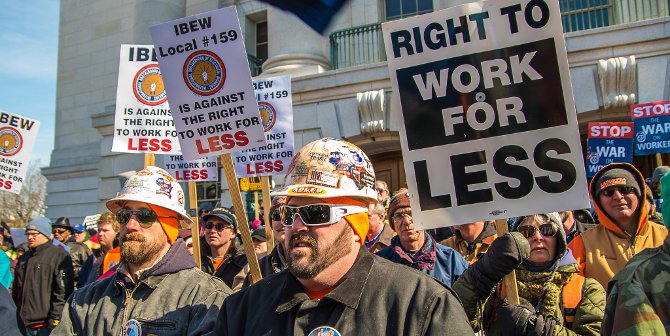
 The United States has dominated international politics since the end of the Second World War. And while it retains tremendous wealth and military strength, the domestic hyper-partisanship which has characterized the post-Cold War era is draining the country’s ‘usable power’ argue Peter Trubowitz and Peter Harris.
The United States has dominated international politics since the end of the Second World War. And while it retains tremendous wealth and military strength, the domestic hyper-partisanship which has characterized the post-Cold War era is draining the country’s ‘usable power’ argue Peter Trubowitz and Peter Harris.
Can the United States continue to shape international politics as it has done for the past 70 years, or is the era of US dominance coming to an end? Most attempts to answer this question focus on America’s relative power – that is, the balance of material capabilities between the US and its geopolitical competitors. However, today the most pressing checks on US leadership come not from foreign competitors, but rather from America’s increasingly dysfunctional domestic politics.
America is suffering from a shortage of functional or ‘usable power.’ While relative power as measured by its military arsenal vis-à-vis those of its rivals has held steady, the domestic political ability of US presidents to turn the country’s tremendous power and wealth into international influence is declining. This has been the case for some time now. America’s deficit of usable power did not begin with Donald Trump, but it has grown measurably on his watch as president.
Presidents’ usable power depends on their ability to win the support of a broad cross-section of the voting public for their foreign policy agenda. Historically, presidents have relied on three tools to gain public buy-in: bipartisanship on Capitol Hill, the leader’s ability to set the terms of debate and the design of economically inclusive policies. Each contributed mightily to the public consensus underpinning US foreign policy for decades after the Second World War. Today, all three are in short supply.
Bipartisanship was the norm in foreign policymaking during the Cold War. Democratic presidents could count on the support of moderate eastern Republicans in Congress; Republican presidents relied on the support of conservative southern Democrats. Domestic voters, who worried about presidents’ partisan motives, found such bipartisan support reassuring.
So did America’s allies and friends overseas. They worried that in the absence of bipartisan support, international commitments taken by one president would be reversed or soft-pedaled when the party out of power gained control of the White House.
This is exactly what has happened since the end of the Cold War. Foreign policymaking has become increasingly partisan and erratic. Incoming presidents now look for opportunities to undo their predecessors’ legacies, something that rarely happened during the Cold War.
In 2001, George W Bush withdrew from the Kyoto Protocol on climate change and opposed the Rome Statute creating the International Criminal Court. Barack Obama ended US involvement in Iraq. Donald Trump withdrew the US from the Trans-Pacific Partnership, pulled out of the Paris Agreement on climate change and renounced the Iran nuclear deal. US relative power may not have changed much since the 1990s, but these examples show the decline in America’s willingness to engage and commit internationally as well as in how credible others view its international pronouncements.
If hyper-partisanship has made US commitments worth less internationally, the absence of a shared vision of America’s international purpose has made bipartisanship harder to produce domestically. To build lasting bipartisan coalitions, presidents must structure the national conversation in ways that convince voters that their administration’s preferred international policies will strengthen national security and increase economic opportunity while making it hard for their political opponents to mount an effective challenge.
During the Cold War, presidents enjoyed considerable success in structuring debate over America’s role in the world. The existence of a ‘clear and present danger’ (i.e. the Soviet Union) to national security helped by making it possible for to frame the case for creating and sustaining an expansive (and expensive) American-led international order in terms of national security and anti-communism.
This formulation contributed to some forms of extremism (such as McCarthyism) and overreach (the Vietnam War). At the same time, it put internationalism on firm bipartisan footing and gave presidents considerable latitude to advance internationalist causes.

“President Trump Boards Marine One en route to Joint Base Andrews” by The White House is Public Domain
Since the end of the Cold War, presidents have struggled to secure domestic support for their foreign policies. In absence of a Soviet-style threat, Bill Clinton, George W Bush and Barack Obama all found their efforts to breathe new life into internationalism buffeted by partisan division and public pressure to ‘do less internationally’. Mounting public disillusionment with globalization compounded matters. This disillusionment is related to the problem of (non)inclusive growth.
There was a time when presidents made sure that their foreign policies paid economic dividends for average Americans. Teddy Roosevelt’s ‘Square Deal’ and Franklin Roosevelt’s ‘New Deal’ both linked grand strategic ambitions abroad to benefit-sharing policies at home. This was also true of US foreign policy during much of the Cold War. Presidents and lawmakers alike could advocate internationalist foreign policies – military preparedness, free trade, foreign aid and so forth – safe in the knowledge that most economic sectors and congressional districts would benefit from their actions.
Even before the Berlin Wall came down in 1989, support for internationalism had started to weaken. From the 1980s onward, less regulation, lower taxes, anti-union policies and de-unionization, and higher profits for the few meant less economic security for the many. As the costs of this neoliberal agenda continued to mount in the 1990s and 2000s, growing numbers of middle- and working-class Americans came to see globalization not as a means to improve their personal circumstances, but rather as a source of growing income inequality and economic insecurity.
The chickens finally came home to roost in November 2016, when America elected a president running on an avowedly anti-internationalist platform.
Donald Trump’s ‘America First’ narrative has tapped into Americans’ economic anxiety. There is little realistic chance, however, that it will bridge the chasms that separate Republicans and Democrats, conservatives and liberals, and internationalists and nationalists.
Trump’s harsh stance on immigration has proven to be very unpopular with the majority of voters, even if it appeals strongly to his base. His embrace of economic nationalism is more popular, but opinion polls show that even Trump’s staunchest supporters in rural America are having second thoughts about his trade war with China. Meanwhile, under Trump, partisanship in Washington has increased to hitherto unimaginable levels.
Can the US put its foreign policy house in order? Yes, but to do so, it is critical to recognize that the source of the problem does not lie in Beijing or Moscow.
The decline in US foreign policy efficacy has deep roots in domestic politics in the US. Restoring America’s usable power will require political spadework on the home front: bipartisan bridge-building, an inclusive political vision to connect national priorities with foreign policy and a sustained commitment to more equitable growth-promoting and redistributive policies. This will be a tall order, to be sure, but presidents have successfully navigated such troubled waters in the past.
- A version of this blog post appeared previously at Chatham House and is based on ‘The end of the American century? Slow erosion of the domestic sources of usable power’ in International Affairs.
Please read our comments policy before commenting.
Note: This article gives the views of the author, and not the position of USAPP – American Politics and Policy, nor the London School of Economics.
Shortened URL for this post: http://bit.ly/2HDlQFv
About the authors
 Peter Trubowitz – LSE US Centre
Peter Trubowitz – LSE US Centre
Peter Trubowitz is Professor and Head of International Relations, and Director of the LSE’s US Centre. His main research interests are in the fields of international security and comparative foreign policy, with special focus on American grand strategy and foreign policy. He also writes and comments frequently on US party politics and elections and how they shape and are shaped by America’s changing place in the world.
 Peter Harris – Colorado State University
Peter Harris – Colorado State University
Peter Harris is an assistant professor of political science at Colorado State University, where he teaches classes on international security, US foreign policy and International Relations theory. He received his Ph.D. in Government from the University of Texas at Austin, where he was also a graduate fellow of the Clements Center for History, Strategy and Statecraft.






